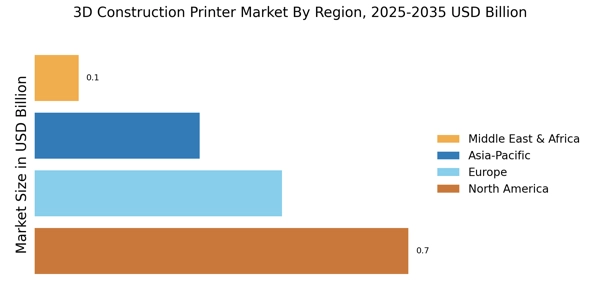Government Support and Regulations
The 3D Construction Printer Market is experiencing a favorable regulatory environment as governments recognize the potential of 3D printing in construction. Various countries are implementing policies and incentives to promote the adoption of innovative construction technologies. For instance, some governments are providing grants and subsidies for projects that utilize 3D printing, particularly in affordable housing initiatives. Additionally, regulatory bodies are beginning to establish standards and guidelines for the use of 3D-printed structures, which enhances safety and public confidence in this technology. This supportive framework is likely to encourage more construction firms to invest in 3D printing capabilities, thereby expanding the market. As regulations evolve, the industry may see increased collaboration between public and private sectors, further driving growth.
Increased Demand for Affordable Housing
The 3D Construction Printer Market is witnessing a surge in demand for affordable housing solutions. As urban populations continue to grow, the need for cost-effective construction methods becomes increasingly pressing. 3D printing technology offers a potential solution by significantly reducing material waste and labor costs. Reports indicate that the use of 3D printing in construction can lower costs by up to 40% compared to traditional methods. This affordability aligns with government initiatives aimed at providing housing for low-income families, thereby driving the adoption of 3D construction printers. Furthermore, the ability to produce homes in a fraction of the time enhances the appeal of this technology, making it a viable option for addressing housing shortages in various regions.
Sustainability and Environmental Concerns
The 3D Construction Printer Market is increasingly influenced by sustainability and environmental concerns. As awareness of climate change and resource depletion grows, construction practices are under scrutiny for their environmental impact. 3D printing technology offers a more sustainable alternative by utilizing eco-friendly materials and minimizing waste. For instance, some 3D printers can use recycled materials, which not only reduces the carbon footprint but also promotes circular economy principles. The construction sector is responsible for a significant portion of global waste, and the adoption of 3D printing could potentially reduce this by up to 70%. This shift towards sustainable practices is likely to attract investment and support from both public and private sectors, further propelling the growth of the 3D construction printer market.
Technological Advancements in 3D Printing
The 3D Construction Printer Market is benefiting from rapid technological advancements that enhance the capabilities of 3D printing. Innovations in materials science, software development, and printer design are enabling more complex and durable structures to be built with precision. For example, advancements in concrete mixtures and composite materials allow for stronger and more resilient buildings. Additionally, the integration of artificial intelligence and machine learning in 3D printing processes is streamlining operations and improving efficiency. As these technologies evolve, they are expected to reduce construction times and costs, making 3D printing an increasingly attractive option for builders. The market is projected to grow at a compound annual growth rate of over 25% in the coming years, driven by these technological improvements.
Labor Shortages in the Construction Industry
The 3D Construction Printer Market is being propelled by labor shortages that are affecting the construction sector. Many regions are facing a decline in skilled labor availability, which poses challenges for traditional construction methods. 3D printing technology offers a potential solution by reducing the reliance on manual labor. With the ability to automate significant portions of the construction process, 3D printers can help mitigate the impact of labor shortages. Reports suggest that the construction industry could face a shortfall of millions of workers in the coming years, making the adoption of 3D printing an attractive alternative. By streamlining construction processes and reducing labor costs, 3D printing may become a key player in addressing the workforce challenges faced by the industry.

















Leave a Comment